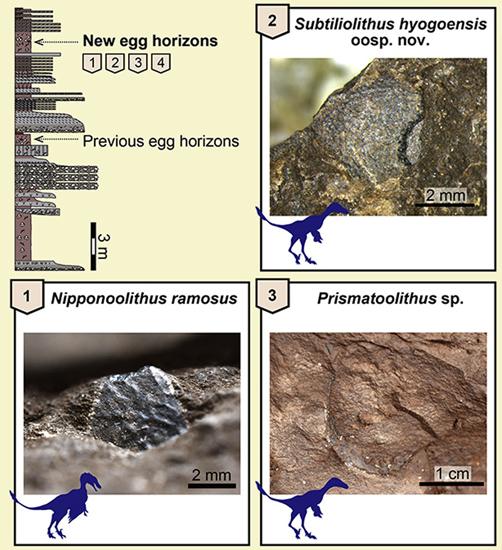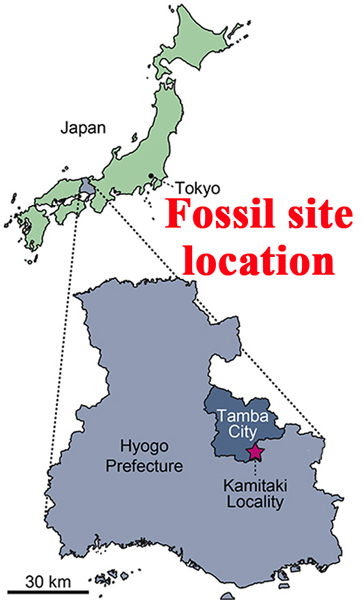Dinosaur Eggs Provide a View on a “Hidden Ecosystem”
Not all the dinosaurs that ever existed are likely to be named and described by scientists. Identifying these long extinct creatures relies on there being a fossil record of some sort to study. A team of researchers writing in the journal “Cretaceous Research”, report on a new Lower Cretaceous fossil egg locality in Hyogo Prefecture, Japan, that provides a tantalising glimpse into a hidden dinosaur dominated ecosystem.
The researchers, which include Kohei Tanaka (University of Tsukuba, Japan) and Darla Zelenitsky (University of Calgary, Canada), describe eggs and eggshell fragments associated with four ootaxa, two of which are new to science. The site reveals a hidden diversity of small dinosaurs, particularly non-avian theropods, in the Hyogo region and indicates the area was utilised for nesting by various small dinosaur species in the Early Cretaceous.
The Newly Erected Ootaxa Himeoolithus murakamii the Most Abundant Ootaxa from the Quarry Site

Picture credit: University of Tsukuba and Museum of Nature and Human Activities Hyogo Prefecture with life reconstruction by Ayaka Nagate
The Kamitaki Locality
The fossil site, known as the Kamitaki locality lies close to the Sasayama River in Kamitaki, Sannan-cho, Tamba City, Hyogo Prefecture. One horizon has yielded a variety of small vertebrate fossils including frogs and lizards, plus a partial tail from a titanosaur that was formally named and described in 2014 (Tambatitanis amicitiae). Eggshell fragments are also associated with this part of the site. However, a horizon some 5.5 to 6.75 metres above the bonebed layer has yielded an astonishing quantity of egg fossils, including a nearly complete egg, several partial eggs and hundreds of eggshell fragments.
The researchers conclude that this horizon represents a nesting area in which a variety of small theropods raised their young.
As a result of this research, two new theropod egg taxa have been named – Himeoolithus murakamii and Subtiliolithus hyogoensis. Although no skeletal remains of these little dinosaurs have been found, the presence of all the egg fossils suggests that there were numerous different types of small theropod co-existing in this ancient ecosystem.
The Location of the Fossil Site within Hyogo Prefecture
Picture credit: University of Tsukuba and Museum of Nature and Human Activities Hyogo Prefecture/Cretaceous Research with additional annotation by Everything Dinosaur
Examining the Mudstone Deposits
The mudstone deposits are thought to have been laid down around 110 million years ago (Albian faunal stage of the Lower Cretaceous) and the palaeoenvironment has been described as floodplain which was subjected to a extremes of seasonality with long periods of very dry conditions punctuated by a very wet season that led to flood events.
The most abundant ootaxon at the quarry, Himeoolithus, is represented by four eggs and over 1300 scattered eggshell fragments. Himeoolithus accounts for over 96% of all the egg fossils associated with this site. Himeoolithus is the smallest non-avian theropod egg known to date, the scientists estimate that the egg probably weighed about as much as a quail egg (around 9.9 grammes). It is also a very unusual shape, being elongate with its length 2.25 times its width (length : width ratio 2.25).
The new egg fossil horizon was discovered in 2015 and was mapped and intensively excavated in the winter of 2019. In total, the egg fossil horizon and the lower Kamitaki Bonebed (Ohyamashimo Formation), have yielded six small theropod ootaxa.
The Stratigraphy of the Kamitaki Locality and Examples of Associated Ootaxa

Picture credit: University of Tsukuba and Museum of Nature and Human Activities Hyogo Prefecture/Cretaceous Research
Notable Biodiversity
The ootaxa demonstrate that this ancient habitat was home to a variety of small theropod dinosaurs. It is likely that many other palaeoenvironments associated with the Lower Cretaceous were also home to a diverse variety of small theropods too, these animals being currently under-represented in the fossil record.
Lead author of the paper, Professor Kohei Tanaka, confirmed that the research team thought that the new egg fossil horizon was a nesting site and the deposit was not the result of a transportation and subsequent burial of egg material from another location:
“Our taphonomic analysis indicated that the nest we found was in situ, not transported and redeposited, because most of the eggshell fragments were positioned concave-up, not concave-down like we see when eggshells are transported.”
Commenting About the Dinosaur Eggs
The professor added:
“The high diversity of these small theropod eggs makes this one of the most diverse Early Cretaceous egg localities known. Small theropod skeletal fossils are quite scarce in this area. Therefore, these fossil eggs provide a useful window into the hidden ecological diversity of dinosaurs in the Early Cretaceous of south-western Japan, as well as into the nesting behaviour of small non-avian theropods.”
Everything Dinosaur acknowledges the assistance of a media release from the University of Tsukuba (Japan), in the compilation of this article.
The scientific paper: “Exceptionally small theropod eggs from the Lower Cretaceous Ohyamashimo Formation of Tamba, Hyogo Prefecture, Japan” by
Kohei Tanaka, Darla K. Zelenitsky, François Therrien, Tadahiro Ikeda, Katsuhiro Kubota, Haruo Saegusa, Tomonori Tanaka and Kenji Ikuno published in the journal Cretaceous Research.
The Everything Dinosaur website: Everything Dinosaur.







Leave A Comment